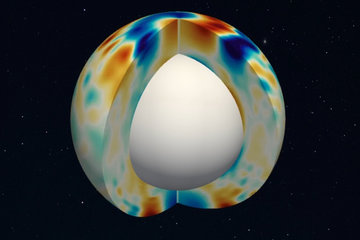All genres
1.
Journal Article
On electron acceleration at CIR related shock waves. Astronomy and Astrophysics 391, pp. 749 - 756 (2002)
2.
Journal Article
The Evolution of the anomalous cosmic ray oxygen spectra during U}lysses slow descent in 1995 to 1998: {COSPIN/LET} and {EPAC observations. Space Science Reviews 97, pp. 363 - 366 (2001)
3.
Journal Article
The evolution of the anomalous cosmic ray oxygen spectra from 1995 to 1998: Ulysses observations. Space Science Reviews 97, pp. 363 - 366 (2001)
4.
Journal Article
Low frequency plasma turbulence and higher energy particles at CIR-related shock waves. Astronomy and Astrophysics 347, pp. 313 - 320 (1999)
5.
Journal Article
Energetic particle abundances at CIR shocks. Geophysical Research Letters 26 (1), pp. 17 - 20 (1999)
6.
Journal Article
Energetic particles in the duskside Jovian magnetosphere. Journal Geophysical Research 104, pp. 14767 - 14780 (1999)
7.
Journal Article
Corotating Interaction Regions at high latitudes. Space Science Reviews 89, pp. 221 - 268 (1999)
8.
Journal Article
Origin, Injection and Acceleration of CIR Particles: Observations - Composition: Averages, Time Variations; Radial and Latitude Variations. Space Science Reviews 89 (1-2), pp. 351 - 359 (1999)
9.
Journal Article
Origin, injection, and acceleration of CIR particles: Observations. Space Science Reviews 89, pp. 327 - 367 (1999)
10.
Journal Article
Particle acceleration efficiency and MHD characteristics of CIR-related shocks. Astronomy and Astrophysics 335, pp. 1101 - 1110 (1998)
11.
Journal Article
Ulysses finished its first revolution around the Sun. Naturwissenschaften 85, pp. 467 - 473 (1998)
12.
Journal Article
What causes the variations of the peak intensity of CIR accelerated energetic ion fluxes? Annales Geophysicae 16 (12), pp. 1552 - 1556 (1998)
13.
Journal Article
The acceleration of charged particles in Corotating Interaction Regions (CIR) - A review with particular emphasis on the Ulysses mission. Surveys in Geophysics 19, pp. 211 - 278 (1998)
14.
Journal Article
Weltraumtechnik im Dienste der Umwelt. Bessere Umwelt 8 (2), pp. 61 - 63 (1998)
15.
Journal Article
The acceleration of charged particles in Corotating Interaction Regions (CIR) - A review with particular emphasis on the ULYSSES mission -. Mitt. a.d. MPI für Aeronomie (MPAE-W-813-98-04) (1998)
16.
Journal Article
Ulysses observations of short-period (( 30 days) modulation of the galactic cosmic rays. Geophysical Research Letters 24, pp. 671 - 674 (1997)
17.
Journal Article
Energetic particle anisotropies and remote magnetic connection at high solar latitudes. Advances in Space Research 19, pp. 855 - 858 (1997)
18.
Journal Article
Weltraumforschung und Weltraumtechnik. Soldat und Technik 2, pp. 104 - 107 (1997)
19.
Journal Article
Field-aligned particle streaming in the duskside high latitude Jovian magnetosphere. Advances in Space Research 20, pp. (2)225 - (2)228 (1997)
20.
Journal Article
Energetic electron beams in the duskside Jovian magnetosphere: Ulysses EPAC and HI-SCALE measurements. Planetary and Space Science 45, pp. 1473 - 1480 (1997)











